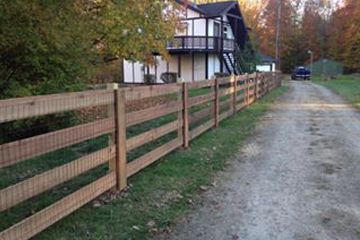The firm of Barnard, Bishop, and Barnard was built up in Norwich to deliver steel fencing by machine. The Anchor Post Fence Co., built up in 1891, purchased the rights to the wire-weaving machine and was the principal organization to produce steel fencing in the United States. Stay Fence additionally holds the primary United States patent for steel. The machine was bought from a man in 1845 from Belgium who initially designed the chain link fencing twisting machine. An improved adaptation of the weaving machine winds two wires around the edge without a moment’s delay to make a twofold helix. One of the spirals is woven through the last winding that is now essential for the fence. This improvement permits the cycle to propel twice as quickly.

Manufacturing chain link fencing:
The assembling of steel fencing is called weaving. A metal wire regularly stirred to lessen erosion, is pulled along a pivoting long and level sharp edge, consequently making a fairly smoothed winding. The winding keeps on turning past the cutting edge and winds its way through the past winding that is as of now part of the fence. At the point when the winding arrives at the furthest finish of the fence, the winding is cut close to the sharp edge. Next, the winding is squeezed level and the whole fence is climbed, prepared for the following cycle. The finish of consistently winding covers the finish of each first winding. The machine clips the two closures and gives them a couple of turns. This makes the connections perpetual.
The establishment of a steel fence includes setting:
Posts into the ground and appending the fence to them. The posts might be steel tubing, lumber, or concrete and might be crashed into the ground or set in concrete. The end, corner, or entryway posts, generally alluded to as “terminal posts”, must be set in solid balance or in any case moored to forestall inclining under the pressure of an extended fence. Posts set between the terminal posts are classified “line posts” and are set at spans not to surpass 10 feet. The installer appends the fence toward one side, extends it, and joins at the other, effectively eliminating the overabundance by “unscrewing” a wire. At last, the installer attaches the fence to the line posts with aluminum wire. By and large, the installer extends a base pressure wire, at times alluded to as “loop wire”, between terminal presents on help limit the in and out development that happens at the base of the steelwork between posts. Top-level rails are utilized on the most steel wall, even though redundant. Base rails might be included lieu of base strain wires, and for the taller wall, 10 feet or more, moderate level rails are regularly included.
Outstanding employments:
Regular statures incorporate 3 ft, 3 ft 6 in, 4 ft, 5 ft, 6 ft, 7 ft, 8 ft, 10 ft, and 12 ft, however practically any tallness is conceivable. Normal work checks are 9, 11, and 11.5. Work length can likewise change dependent on need, with the standard precious stone size being 2″. For tennis courts and ball stops, the most well-known statue is 10 or 12 feet, and tennis courts utilize a jewel size of 1.75″ estimated level side to level side. Tennis courts regularly utilize this littler precious stone size with the goal that power hitters won’t have the option to hold up the ball into a bigger jewel size.

